Case study: External PIM effects on
co-located 700 & 800 MHz sites
NOV 2, 2021
External PIM (PASSIVE INTERMODULATION) and the effect on antenna system performance
The introduction of 700 MHz band at sites with LTE800 systems will cause problems with external PIM sources.
As the number of systems and Frequency bands per BTS site increases, it is critical to identify and mitigate external PIM sources. If not addressed, external PIM issues has a significant negative impact on the site ability to deliver coverage, capacity and generate revenue. In the example below the noise level increase by as much as 7.5dB per 10 MHz.
If we take the example of an operator in Europe, who 5 years ago deployed their LTE (Long Term Evolution) systems in the top 10MHz of the LTE800 spectrum. The IM order for the system would have been a 9th order (in-band) and therefore, when commissioning their installation, they would have tested for an IM3 level of -140dBc at 2x20W, which 5 years ago would have been considered as an acceptable level.
We have performed some mathematical approximations by modelling a nonlinearity model to fit the measured IM3, IM5, IM7 and IM9. We are also assuming that the system noise figure is 2dB and will be using a resolution bandwidth of 10kHz.
.JPG.aspx?lang=en-US)
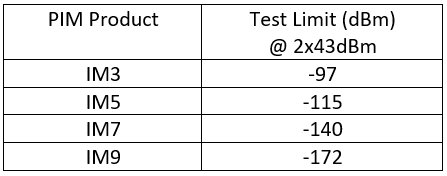
Looking at the PIM Spectrum for this LTE800 (10MHz BW) system in isolation, we cannot see any change in the system noise floor.
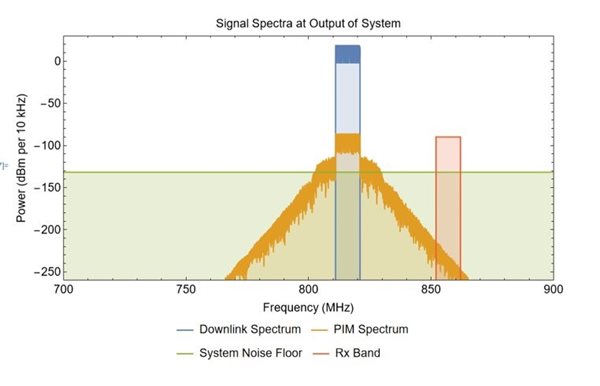
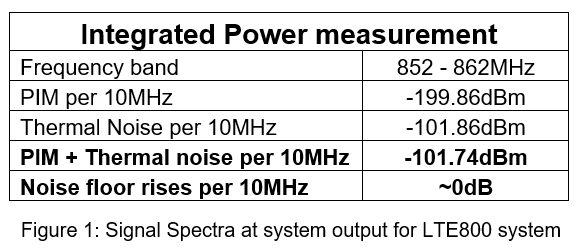
Let’s now assume that the same operator has acquired 10MHz of spectrum in the 700MHz band. The operator might decide to install the 700 system on the same site as the LTE800 system already in place.
If the operator does not try to improve the residual PIM level on site, which has been established to be –140dBc with 2x20W, then as he introduces the 700MHz band, he can expect a noise rise of 7.5dB per 10MHz, which will significantly impact the site ability to generate revenue: the coverage will be significantly reduced.
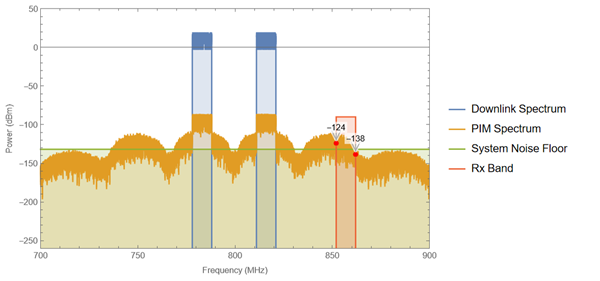
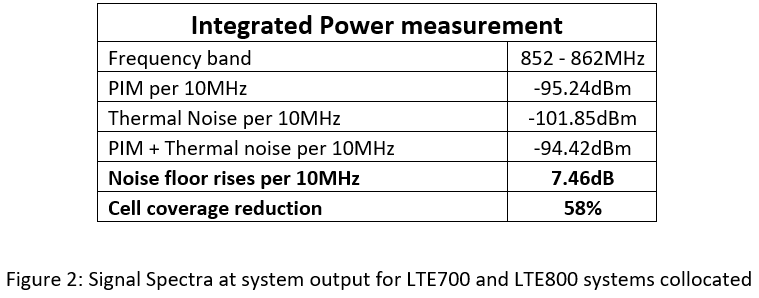
The main reason for this increase in PIM level is not only the additional signal being generated but also the order of the IM products falling within the receiver band: when the LTE800 is used in isolation, the in-band IM order is only a 9th order, but when it is collocated with the 700 band, the IM order becomes a 3rd order IM due to the new carrier spacing. This operator drew the short straw when he was allocated the top 10MHz of the LTE800.
It is also important to note that external PIM sources exacerbate this problem: even if the systems are not one the same feeder but are implemented on separate antennas, the signals from both systems can mix externally and generate 3rd PIM products in both receivers. External PIM are the products of unwanted signals created by mixing two or more strong RF signals in a non-linear device, such as loose screws, poor metal to metal contact (usually around metal brackets) and rusty materials.
Kaelus has introduced the PIM Finder solution to help the operator identify the external PIM sources to improve their system noise floor, You can see how external PIM is detected and mitigated in this video.
|
The Kaelus PIM Finder solution is easy to set up and operate. With one hand operation it is possible to efficiently search for the external PIM source. Kaelus Unify, run on a tablet, will indicate visually and with sound when external PIM is found. Using the Kaelus Portable PIM tester (IPA or iXA), the technician will only be exposed to a low 2x40W peak power while performing the PIM troubleshooting activities, which with 10% duty cycle is only 8W exposure.
|
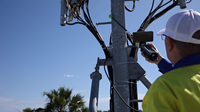 |
Once the external PIM sources has been identified, there are different mitigation possibilities: a simple action is to remove or hide the source using radio frequency (RF) barrier that can be deployed on rooftops, both in front of as well as behind based station antennas to help isolate source of PIM.
Introducing more frequencies in the network and increased TX power will increase risks for noise by external PIM.
Are you concerned about external PIM? Contact us or have a look at Kaelus PIM Finder solution.